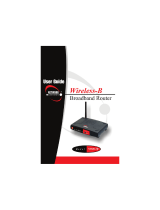
Wireless-G Broadband Router with 2 Phone Ports
1
Chapter 1: Introduction
Welcome
Chapter 1: Introduction
Welcome
Thank you for choosing the Linksys Wireless-G Broadband Router with 2 Phone Ports. This Router will allow you
to network wirelessly better than ever, sharing Internet access, files and fun, easily and securely. Plus, after you
have set up your babyTEL service, you can make phone or fax calls using your Internet connection.
How does the Router do all of this? A router is a device that allows access to an Internet connection over a
network. With the Wireless-G Broadband Router with 2 Phone Ports, this access can be shared over the four
switched ports or via the wireless broadcast at either up to 11Mbps for Wireless-B or up to 54Mbps for
Wireless-G. In addition, the WPA standard provides greater security opportunities while the whole network is
protected through NAT technology. All of these security features, as well as full configurability, are accessed
through the easy-to-use browser-based utility.
But what does all of this mean?
Networks are useful tools for sharing Internet access and computer resources. Multiple computers can share
Internet access, so you don’t need more than one high-speed Internet connection. After you have set up your
babyTEL account, you can also use your Internet access to make Internet phone or fax calls, even
while you’re surfing the Internet. Plus, you can access one printer from different computers and access data
located on another computer’s hard drive. Networks are even used for playing multiplayer video games. All the
while, the Router protects your networks from unauthorized and unwelcome users. So, networks not only are
useful in homes and offices, but also can be fun.
PCs on a wired network create a LAN, or Local Area Network. They are connected with Ethernet cables, which is
why the network is called “wired”.
ethernet: an IEEE standard network
protocol that specifies how data is
placed on and retrieved from a common
transmission medium.
lan (local area network): the computers
and networking products that make up
the network in your home or office.
browser: an application program that
provides a way to look at and interact
with all the information on the World
Wide Web.
mbps: one million bits per second; a unit
of measurement for data transmission.
nat (network address translation): NAT
technology translated IP addresses of a
local area network to a different IP
address for the Internet.
wpa (wi-fi protected access): a wireless
security protocol using TKIP (Temporal
Key Integrity Protocol) encryption, which
can be used in conjunction with a
RADIUS server.




















